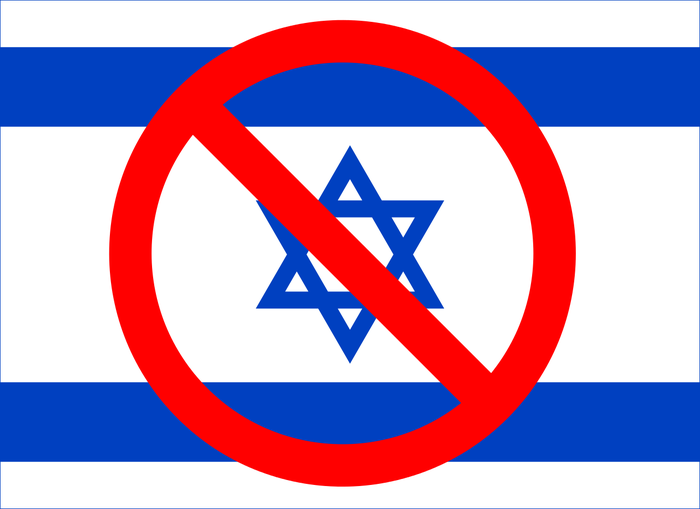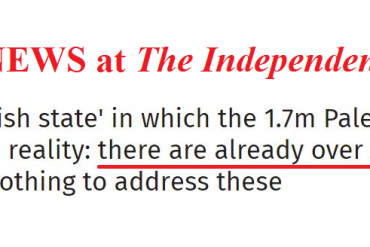In the course of only a week, the Guardian has published three pieces legitimising or promoting the end of the Jewish state. On July 15, we posted about a Guardian op-ed by Joshua Leifer, Peter Beinart’s colleague at Jewish Currents, which amplified Beinart’s new anti-Zionist epiphany.
Today, they published two more pieces on the topic: One straight news article by Michael Safi (“Jordan could ‘look positively’ on one-state solution if Palestinian-Israeli rights equal”, July 20) and an op-ed by Ahmed Moor (“Whether Israel annexes the West Bank or not, a two-state solution is no longer viable”, July 20).
Safi’s article is notable not because it cites Jordan’s prime minister saying that his country could view positively a “one-state democratic solution”, but that it practically ignores the fact that a non-Zionist future is considered an existential threat by Israelis, and most diaspora Jews.
Typical is this sentence:
Israeli leaders have traditionally eschewed any kind of one-state solution, fearing that the Palestinian population would eventually eclipse the Jewish one and threaten Israel’s religious identity.
First, it’s not just “Israeli leaders” who have “traditionally” opposed a one-state solution. It’s practically the entire Jewish Israeli population since 1948. Further, the opposition doesn’t merely stem from a narrow concern that the country’s religious identity would be threatened. It’s based on the fear that Jews’ continued existence in the region would be threatened in any Palestinian majority state. The suggestion that Jews in Israel would, under any circumstances, entertain such an idea is ludicrous.
The other piece published in the Guardian today, an op-ed by Palestinian-American writer Ahmed Moor, who co-edited the book After Zionism: One State for Israel and Palestine, and was organiser of a “One State Conference” at Harvard in 2012, is even more detached from reality.
After discussing why he thinks the two-state solution is dead, Moor then lays out his own anti-Zionist vision:
[Israel-Palestine] may be organised into four federal units: Gaza, the West Bank, the Galilee and Coast, and the Naqab or Negev. Two states will be majority-Palestinian and two states will be majority-Jewish, a likely necessary concession to the country’s legacy of ethnic conflict. Federal elections would distribute power on a proportional party basis, while each federal unit may exercise limited decision-making authority on certain matters. Mandatory national service required of all citizens could help forge a coherent, post-conflict identity rooted in common histories and experience.
Though he lays out the limited autonomy that these federal units (some majority Jewish and some majority Palestinian) will enjoy, Moor doesn’t explain who will protect Jews in who live in the Palestinian majority West Bank unit. Nor does he explain why he thinks Hamas and other terror groups in the Gaza unit will lay down arms and decide to live peacefully with Jews who they’ve continually threatened to slaughter.
Interestingly, he touched on this issue in a 2010 Mondoweiss post, where he wrote that each federal unit will have it’s own militia. That’s right: so, Jews living in a Palestinian majority West Bank district will be ‘protected’ by a Palestinian militia, and Hamas – yes, Hamas – will be part of Gaza’s armed militia. But, of course, to assume that Hamas wouldn’t use their arms – and additional weaponry they’d likely import from Iran and other friendly states – against the Jewish majority federal districts is risible.
And, herein lies one of the many fatal flaws in the arguments of those, like Beinart and Moor, who argue for a one-state future: It doesn’t even minimally address why they think why even average Palestinians – 93% of whom according to polls are antisemitic – yet alone heavily armed terror groups, will lay aside their extreme animosity and live in peace and harmony with the Jewish minority.
Such thinking isn’t merely Utopian, but delusional: especially in it’s belief millions of Jews will voluntarily trade-in the prosperity and safety of a state that allows the Jewish expression and culture to flourish like it can nowhere else in the world for the faint hope that they’ll be a tolerated minority in a majority Palestinian state.
The fact that the Guardian – which always insisted it supported two states – is now promoting such lunacy is arguably an indication that, in their eyes, its endorsement by Beinart has rendered the anti-Zionist ‘solution’ more intellectually acceptable – the values and existential fears of the overwhelming majority of the world’s Jews be damned!
Related Posts
- Disinformation abounds in Vox annexation ‘explainer’ (CAMERA)
- BBC’s ‘hardtalk’ recycles inaccuracy previously acknowledged and corrected (CAMERA UK)






I think everyone knows how anti-Israel the Guardian is which is why it is nearly bankrupt
You mention in this article that the concept of a “2 state solution” (which, of course, was never a “solution” to begin with) has been supported by “practically the entire Jewish Israeli population since 1948”. I do not think that is true and more importantly, I do not think that it is true today. The Israeli support for a Palestinian state where Israel gives up land certainly was not the case between 1948-1967 when Israel had no land to give away (not that it can afford to give away Judea and Samaria today). From my recollection, it was only first uttered by Netanyahu in his infamous Bar Ilan speech. Today there is a groundswell of support for extending Israeli law over portions if not all of Judea, Samaria and the Jordan Valley and perhaps allowing limited autonomy for the Arabs who live in those areas but would not be citizens of Israel. Polls have indicated that only a minority of Israelis are in favor of a Palestinian state in Judea and Samaria.
I didn’t write that the two-state solution has been supported by the entire Jewish Israeli population since 1948. I wrote that a “one-state solution”, in which Palestinians would be the majority and Jews the minority (that is, an anti-Zionist solution) has been opposed by Jews since ’48.